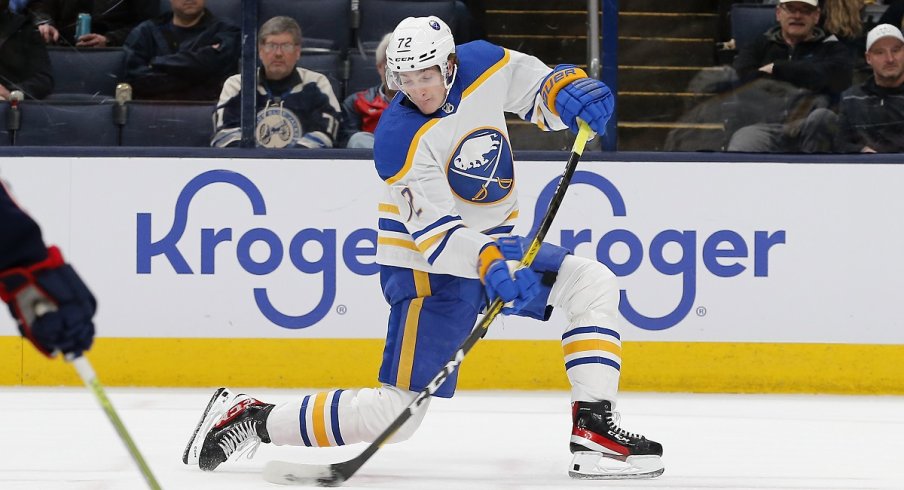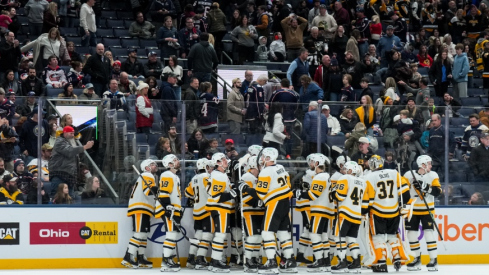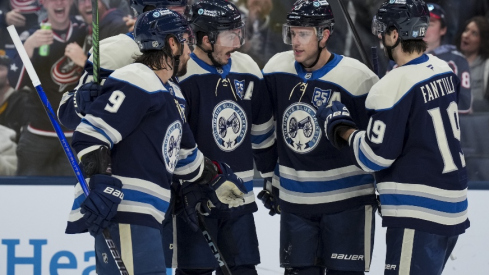What lessons can the Columbus Blue Jackets learn from Buffalo Sabres' forward Tage Thompson?
In order to answer that question, we need to go back in history and discuss one of the genuinely fascinating origin stories of the NHL.
Thompson wasn't always seen as a can't-miss player who would become an NHL star. As a lanky teenager, he was a middle-of-the-lineup player on the USNTDP team, a team that coincidentally featured Jack Roslovic and was headlined by Auston Matthews and Matthew Tkachuk. As a freshman at notable non-blue-blood NCAA program UConn, he scored 14 goals... and 13 came on the power play. He was a one-trick pony, a power play specialist. That production doesn't typically project to the NHL. That summer, he was drafted in the first round, 26th overall, to the St. Louis Blues, with the hope that the then 6'5" inch forward would grow into his body and develop alternative facets of his game. After just 41 games with the Blues, in which he posted 3-6-9 (G-A-PTS), the club traded their 20-year-old as part of a package to acquire Ryan O'Reilly from the Sabres.
His age 21, 22, and 23 seasons in Buffalo were mostly uninspiring, as Thomspon posted a pedestrian 15-11-26 in 104 games. Most concluded that the Blues 'won' the trade, particularly as O'Reilly went on to help the Blues win their first Stanley Cup in 2019. Still, Buffalo remained committed to playing its young players, even as the team remained in the basement standings.
Then, last season, the 6'6" forward (eliteprospects lists him at 6'7") burst onto the scene, shattering his previous four-season totals by tallying 38-30-68 in 78 games. The Sabres bet on their budding player in the offseason, signing him to a 7-year, $50M contract ($7.143M AAV) that kicks in starting in 2023-24. And so far this year, the 25-year-old has posted a gaudy 23-21-44 in just 29 games, a 65-goal pace over 82 games. This is a player who was a regular healthy scratch under the Sabres' previous
truly one of the best hockey stories of the past... decade? who possibly saw this coming? and he becomes a total unicorn. awesome https://t.co/4Vj8Sd7crT
— JFresh (@JFreshHockey) December 8, 2022
As it stands today, Thompson trails only Connor McDavid and Leon Draisaitl in points, and only McDavid in goals. He's a top NHL player by virtually any metric. The Blue Jackets saw up close the skill set that Thompson possesses, as he scored five goals in a game just a week ago.
What makes Thompson a special talent is that he has managed to blend a few elite skills. The first is his wicked shot. He has, aside from Matthews, probably the best drag shot in the NHL, and aside from Alex Ovechkin, probably the best one-timer. Second, his hands are world-class, and that's unusual for a player at his height. His long reach, coupled with his stickhandling ability, is a nightmare for opposing defenses and goalies. Third is his hockey sense, namely his ability to find soft spots in the ice. Put that together, with a few years of patience, and you have an NHL star.
So, how does any of this apply to the Blue Jackets?
The Blue Jackets have a young core of prospects, none of whom are considered star players today, which includes, but is not limited to, Cole Sillinger, Kent Johnson, Yegor Chinakhov, Kirill Marchenko, David Jiricek, Denton Mateychuk, and Corson Ceulemans. For this team to take a step, it is compulsory that a star player (or several) is mined. That group is exclusively aged 18-22. When Thompson was 22, he was not a top-of-the-lineup player.
To be clear, I'm not insinuating that Sillinger, for example, is the next Thompson. More so that development is not linear, and it does take time. If Sillinger were playing far away in the WHL, would Blue Jackets fans be more optimistic about his upside, somehow excited by the unknown?
The Athletic's Sean McIndoe recently wrote a hilarious piece cautioning the five lessons NHL GMs will incorrectly take from Thompson. From his piece:
So what have we learned from the Tage Thompson experience?
Maybe lots, if you’re an NHL GM. The main lesson is that everyone needs to stop being mean to you and start having more patience, because your draft busts are good and your worst trades were brilliant. Also, bet on big guys with no track record and crazy-high shooting percentages. What could go wrong?
I think the better lesson is that we can’t learn anything. No, really, I think that’s the best option here — not for GMs, but for fans. Yes, we could try to pick apart Thompson’s last two seasons and try to extrapolate legitimate hockey lessons. But isn’t it more fun if we just shrug and enjoy the ride?
Maybe Tage Thompson is just a hockey unicorn, one that can’t be explained, only enjoyed. Don’t try to capture it for further study, because it will get spooked and gallop away, never to be seen again. Instead, just sit back and appreciate the magic. Right up until it shrugs off two checkers and goes top shelf on your goalie in overtime.
While I think McIndoe is mostly right - the typical struggling fourth-liner with size and a first-round pedigree isn't likely to take a monster leap - I do think there's room for nuance. After all, the Sabres, who have been among the worst franchises in hockey for the past decade, got it right with Thompson. They were patient. They gave him a regular shift. Head coach Don Gronato, who has known Thompson going back to the USNTDP days, saw Thompson's skills as assets and put him in a position to realize his potential.
Who can say if the next Thompson is in the Blue Jackets organization? To me, the takeaway isn't to bet on size. Or to bet on players with a high shooting percentage. Or that GMs shouldn't trade former first-round picks. It's that what matters most for players to reach their potential is that they play to their strengths and in an environment where players can play a regular shift and be supported by their coaching staff to develop the right way. It almost never happens overnight. Hell, it may not happen at all. But the Blue Jackets are in desperate need of its young players to take major leaps in the coming years. Watching Thompson dice them up for five goals should be a good enough reminder of why that matters.


